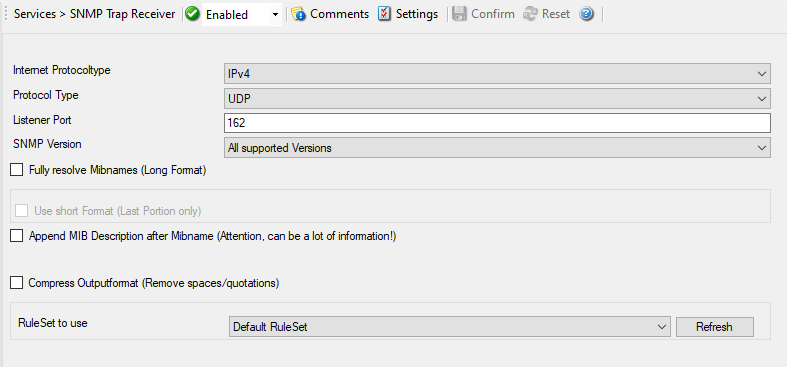SNMP Trap Receiver¶
SNMP Trap Receiver allows you to receive SNMP messages. A rough description of a Trap is that it is somewhat like a Syslog message, just over another protocol (SNMP). A trap is generated when the device feels it should do so and it contains the information that the device feels should be transmitted. It also contains some (few) standard items, as the version, community etc.
The SNMP Trap Receiver Service runs continuously based on the configuration mentioned below:

Service - SNMP Trap Receiver*
Internet Protocoltype¶
- File Configuration field:
nInetType
- Description:
Select the desired protocol type. IPv4 and IPv6 are available. The IPv6 protocol needs to be properly installed in order to be used. Note that one Service can only handle IPv4 or IPv6, so if you want to use both protocols, you will need to create two separate services.
Protocol Type¶
- File Configuration field:
nProtocolType
- Description:
You can select to listen on UDP or TCP protocol for SNMP Traps.
Listener Port¶
- File Configuration field:
nPort
- Description:
The port the SNMP listener is listening to. If in doubt, leave it at the default of 162, which is the standard port for this.
SNMP Version¶
- File Configuration field:
nSnmpVersion
-1 = All Supported Versions
0 = SNMP Version 1 only
1 = SNMP Version 2c only
- Description:
Can be used to restrict the SNMP versions. The availabe values are:
All Supported Versions (i.e. SNMP Version 1 and SNMP Version 2c only)
SNMP Version 1 only
SNMP Version 2c only
Fully Resolve Mibnames (Long Format)¶
- File Configuration field:
nResolveLongMibNames
- Description:
This Option fully resolves the Mibnames like in the Client Mibbrowser Application.
Use short Format (Last Portion only)¶
- File Configuration field:
nResolveMibNamesShort
- Description:
Fully resolved mibnames including their tree can become very long and unreadable. Use this option to shorten them to the last portion of the full mibname.
Append MIB Description after Mibname¶
- File Configuration field:
nAddMibDescriptionToMsg
- Description:
Append MIB Description after Mibname. Attention, can be a lot of Information.
Compress Outputformat (Remove spaces/quotations)¶
- File Configuration field:
nCompressOutputFormat
- Description:
When enabled the output format will be reduced to a minium and comma separated. Here is a sample output:
source=127.0.0.1, community=public, version=Ver2,iso.3.6.1.2.1.1.3.0=Timeticks: (3493305159) 404 days, 7:37:31.59,iso.3.6.1.6.3.1.1.4.1.0=OID: iso.3.6.1.4.1.19406.1.2.2,iso.3.6.1.4.1.19406.1.1.1.7=This is a SyslogTest
General Values (Common settings for most services)¶
RuleSet to Use¶
- File Configuration field:
szRuleSetName
- Description:
Name of the ruleset to be used for this service. The RuleSet name must be a valid RuleSet.
Please Note:
Managing incoming Traps works the same way as with a Syslog server for example.
Incoming Traps will be forwarded to the corresponding Ruleset and pass by rule after rule. There it can be filtered for general information like the “Community”, the “Version” or “Value” for example. Finally it will be processed by an action, which you can select to your needs. The SNMP Agent service will co-exist peacefully next to the Windows SNMP Agent and will not hinder it in its functionality. The Windows SNMP Agent listens to port 161, while MonitorWare Agent and WinSyslog listen to port 162.**
For internal processing, the variables of incoming SNMP messages will be added to a new property. Those properties will be named %snmp_var_x% with the x being a number starting with 1. You can use these custom properties for filtering and everywhere where you can use or print properties. For example, you can create a “send mail”-action. Here you can specify complete freely how the message will look like. You can use a introductory text and then let it show the error message in some context. This could look like this:
Hello Admin,
the following error occurred
%snmp_var_5%
Please take care at once.
Very urgent!
The result will be, that the 5th property of the snmp trap will be inserted into the message text.